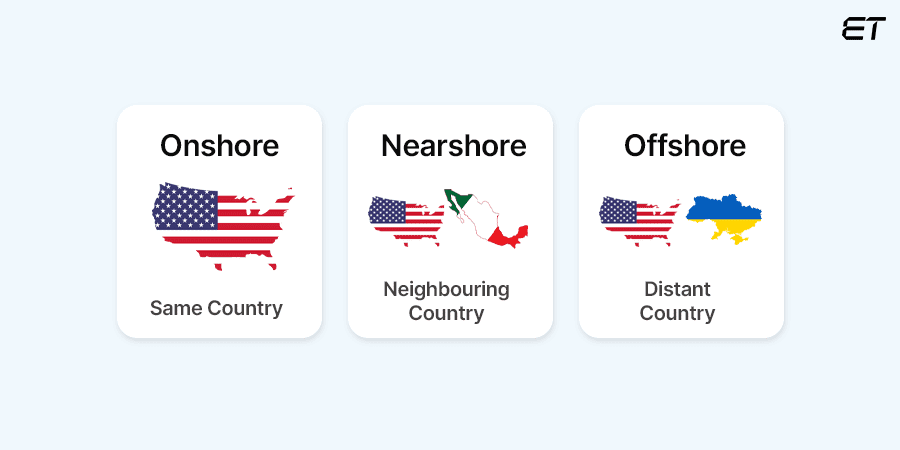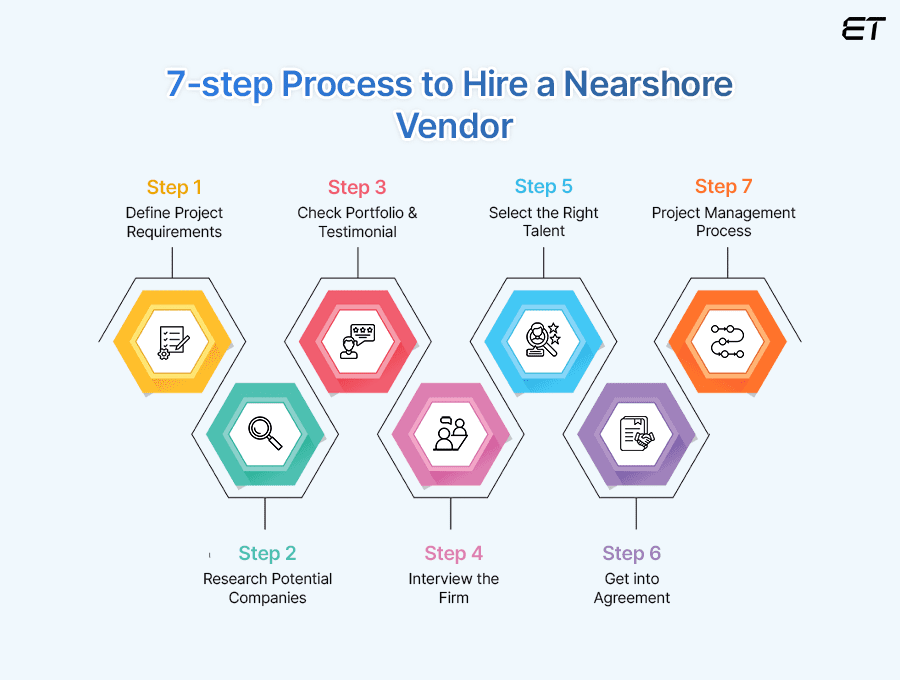What is nearshore software development?
Well, to understand this concept, it is vital to know some essential background points.
Get this – A business’ operational and strategic agility must be considered to grow exponentially. Technology plays a significant role in ensuring that this agility can respond competitively. One of the choices could be whether to begin internal software development first or to seek an outsourcing partner.
Contracting out business operations and processes to outside vendors is known as outsourcing. There are tons of advantages of outsourcing, ranging from cost reductions and increased efficiency to a more decisive competitive advantage.
Today we will cover a form of outsourcing that is relatively popular nowadays and has benefited both start-ups and established businesses greatly – ‘Nearshore Software Development.’
Nearshore Software Development – Quick Look at the Necessity
A poor cultural match, language difficulties, and time zone differences can discourage some clients from trying outsourcing or offshoring. So, the alternative solution to these challenges is hiring nearshore software developers.
Nearshore software development is one of the best options for many world-famous organizations, like Google, Tesla, Porsche, Johnson & Johnson, IBM, and many others. According to a Clutch report, nearshore software outsourcing companies will be employed by over 21% of organizations for outsourcing tasks.
Simply put, the process of offshoring tech operations, web development, or app development to a nearby nation is known as nearshore software development. For example, a US-based business may outsource some of its work to Mexico.
Hiring Nearshore developers from a top nearshore software development company is an excellent option to employ your required talent at affordable prices. Finding the right talent in this dynamic digital world is quite challenging. Even more difficult is finding excellent personnel who can operate in an Agile way and produce the results you want for your software development project.
Fortunately, we are in the heyday of globalization, where nearshore software development teams have shown they can work effectively and collaboratively from a distance can be more effective. But if you want to understand nearshoring in depth, this blog will prove useful.
Types of Software Outsourcing
Software outsourcing can be categorized in various ways based on location, relationship, and contract type.
Here’s a breakdown:
- Onshore Outsourcing: Outsourcing to a company within the same country
- Nearshore Outsourcing: Outsourcing to a neighboring country
- Offshore Outsourcing: Outsourcing to a distant country, often with significant time zone differences
- Multi-shore Outsourcing: Combining two or more of the above options to leverage different benefits
- Staff Augmentation: Hiring external developers to supplement your in-house team
- Managed Team Outsourcing: Outsourcing an entire team, including management, to an external provider
- Project-Based Outsourcing: Outsourcing a specific project with defined scope and timeline
- Fixed-Price Model: A predetermined price for the entire project
- Time and Materials Model: Paying for the developer’s time and the cost of materials used
To choose the right model, you should consider various factors as follows:
- Project size and complexity
- Budget constraints
- Required skill set
- Timeframe
- Control and risk tolerance
So, always take the best decision that suits your company’s needs.
What is Nearshore Software Development Outsourcing?
In the form of outsourcing, known as Nearshoring, a corporation looks for a development partner in another nation or region. The fact that the custom software development partner is still nearby sets Nearshoring apart from other forms of outsourcing.
Since businesses are typically located in the same time zone, communication is facilitated, and regular visits are permitted.
A team of software engineers from surrounding nations within a 1 to 3-hour time difference work with a customer under the nearshore software development model. The distributed teams of a nearshore software development company are located in nations with similar time zones.
For example, Nearshoring allows a company in Canada or Mexico a greater chance to find the dedicated developers they need without the usual outsourcing challenges such as significant time gaps or cultural differences. In this case, hiring dedicated developers in New York (US) is Nearshoring.
Nearshore development is best for:
- Solutions for B2B, B2C, and SaaS
- Businesses using an Agile strategy
- Companies who do not necessarily require face-to-face interaction but real-time collaboration
- Creation of innovative software solutions
- Complicated legacy software solutions modernization
- Projects that need teamwork and real-time discovery are more strategic and ambiguous
Many people confuse Offshore and nearshore software development. But the main distinction between them is the time zone. Let’s examine the key differences between Nearshore and Offshore development. The Nearshore development approach is ideal for businesses concerned about big geographic disparities. It enables them to delegate product development to local professionals.
This strategy strikes a balance between offshore, where there are more than four time zones between the customer and the team, and onshore, where there are fewer risks.
Let’s go over the top reasons to choose Nearshore development for your upcoming project.
Top Reasons to Choose Nearshore Software Development Services
Read the points below to explore why hiring nearshore developers is a good decision.
Lack of Cultural Differences
Language and cultural hurdles that make it difficult to achieve objectives and meet deadlines can be lessened through nearshore outsourcing. Along with being highly skilled developers with excellent communication skills, you get professionals with a thorough understanding of cross-cultural requirements through nearshore software development.
Shorter Lead Time
When you outsource your project overseas, it typically takes 10-20 weeks for completion. This timeline can cause problems for companies who need the work done sooner. Shorter lead times are one of the main reasons companies are looking to hire Nearshoring firms.
Proximity to your Team
The close proximity to your workforce is one of the main reasons for outsourcing a Nearshore software development company. With Nearshore outsourcing, you may communicate with your development staff during business hours. Hence it is easier to maintain transparency during each phase of product development.
Better Control
By choosing Nearshore outsourcing, you might have more control over your project and find it simpler to establish relations with personnel closer to you.
Cut down Development Cost
Any reliable Nearshore software development company will offer the labor, technical resources, and professionals required to develop your organization’s website as effectively as possible.
This tactic helps your business save time and money. You won’t have to hire and educate new software developers, clear up additional office space, or pay individual wages.
Benefits of Nearshore Software Development Outsourcing
1. High Quality
One prevalent issue when working with outsourced teams is that poor communication results in work being performed by mediocre engineers. By naturally removing a lot of this ambiguity and misunderstanding, Nearshore software development increases the possibility that your needs will be satisfied immediately and thus improve quality.
2. Enhanced Speed
Time zones greatly influence turnaround times for projects using outsourced teams. Even though certain nations might provide service around-the-clock, there will always be a delay because of distance and cultural differences. However, the productivity of a Nearshored workforce has increased, and delays are decreased due to immediate responses and quick bug fixes.
3. Easier to Scale Teams
A dedicated software development team, comprised of developers, designers, QA analysts, and managers, is necessary for some projects. Because there is no need to set up an office for the development team, Nearshoring saves money and makes it simple to modify the size of the team as project requirements change.
4. Cost-Effective
The main advantage of Nearshoring versus Onshore software development is cost-effectiveness; outsourcing to local enterprises is typically far more expensive. The overall cost of a software development project can be reduced by up to 70% in Nearshore development. This could be crucial for firms looking to save expenses without compromising quality or for startups with limited resources.
5. Timely Feedback
In the early morning hours, you receive updates on your company and have time to study and give feedback on the work the Nearshore development company has completed. This is especially true if your headquarters are in the USA and your committed team is in Eastern Europe. The next day, the nearshore software development team can send over the required modifications.
6. Access to a Skilled Team
By using nearshoring, you can gain access to subject-matter specialists that are familiar with modern technology and most likely have experience working on projects similar to yours. The overall development process is more beneficial and productive when access to such a talent pool exists.
If there is a market for cutting-edge technology, you might locate a nearshore firm or experts abroad. For instance, you can discover rare but in-demand experts in Scala and AI/ML technologies in Eastern Europe, primarily in Ukraine.
How to Choose a Nearshore Software Development Company?
Selecting a top-tier Nearshore software development company can be challenging, especially for projects requiring a significant investment. When looking for a team to work with, it’s crucial to establish a set of rules to adhere to.
Let’s look at a few of these points to consider.
Experience and Expertise
The nearshore company’s skills should be taken into account first.
A team experienced with your particular technology is crucial because software development is a broad discipline with many subspecialties. Any organization intending to Nearshore a team of software developers must make sure to thoroughly investigate their specializations and level of experience in their respective fields.
Check with Previous Clients
Get feedback from references regarding their interactions with a specific business. This outreach will give you an idea of how well (or poorly) they perform on projects and whether or not they can meet deadlines.
Evaluate Team Size
When selecting a nearshore software development team, size is yet another aspect to consider. This isn’t to argue that a more visible and bigger team is always preferable, but your requirements can call for a specific team size.
For a project to make up for its scale and improve its chances of success, it would need more personnel and a larger development center. Smaller teams, however, would be more cost-effective and simpler to manage for a smaller project.
Consider Your Budget
Budgeting is essential to any project, and software development is no exception. Be sure to consider your budget constraints and talk this through with the development company. Understand if there will be any additional costs in advance so you can account for these when budgeting.
Consider the projected timeframe and how this will also affect your budget.
Check their Reputation
Although skills on paper are essential, you should also find out what previous clients thought of their customer service and the quality of their work. Check through internet testimonials and reviews. Check if the company is on the list of top-rated Clutch dedicated developers.
Moreover, your shortlisted Nearshore vendor must describe the projects they performed for previous customers and how they met their needs with the best possible solutions.
Compliance to Laws
There are rules that you must follow when developing an application. For instance, if you are primarily interested in the European market, you must adhere to the GDPR(General Data Protection Regulation).
There are specific regulations known as the CCPA that apply to California residents. (California Consumer Privacy Act). Make sure a company adheres to the regulations established by your region before signing a contract and hiring any Nearshore developer.
Communication Procedure
Organizations should be able to communicate easily with the project team when outsourcing. When necessary, the company must have a direct line of communication open with the nearshore software development team.
The development process could be hampered if there is no appropriate communication route. Furthermore, the discrepancy in working hours makes communication much more difficult.
Therefore, businesses should pick a Nearshore provider that is accessible at all times.
Match with Your Methodology
You must discover the ideal software development process to benefit your business and organization. When you want to work with a Nearshore software development company, careful planning and the assistance of a project manager can help you choose the best methodology.
How To Choose the Best Nearshore Software Development Outsourcing Company for Your Business
Follow the steps below to hire the right talent for your next project.
Step 1: Define Project Requirements
Your project’s scope, goals, deadline, and budget should all be clearly stated. This will enable you to decide what tools and experience you require from a software development company.
Here are some key areas to define when outlining your project requirements:
- Project Goals: What are you hoping to achieve with this software? Who is the target audience?
- Functionality: What features and functionalities are essential for your software? Prioritize them if there are many
- Technical Specifications: Are there any specific technologies, programming languages, or frameworks you need the partner to be familiar with?
- Timeline and Budget: Do you have a specific timeframe for completion? What is your allocated budget for the project?
- Security and Compliance: Are there any security or data compliance regulations that the software needs to adhere to?
Having a solid foundation from the beginning will significantly increase your chances of finding the perfect nearshore software development partner for your project.
Step 2: Research Potential Companies
Search for businesses with a proven track record of completing successful projects and experience in projects similar to yours.
Start with Location.
Decide on nearshore locations that align with your needs. Consider factors like time zone overlap, cultural similarities, and development costs. Next, look for countries known for strong software development capabilities and a talent pool with expertise relevant to your project.
Next, visit the websites of potential partners. Look for information about their services, experience, team structure, and development methodologies (like Agile or Waterfall).
Search for online reviews and client testimonials on the company website or third-party platforms like Clutch or GoodFirms. These can provide valuable insights into the company’s work ethic, communication style, and ability to deliver projects successfully.
Step 3: Check Portfolio and Testimonials
Examine their case studies and portfolios to get a sense of the quality of their work and the results they have obtained for other clients.
For evaluating portfolio, check the following aspects:
- Project Alignment: Look for projects in your industry or with similar functionalities to your own
- Project Complexity: See if the company has tackled projects of similar size and complexity to yours
- Technology Expertise: Review the technologies used in their portfolio
- Quality of Work: Pay attention to the visual design, user interface (UI), and user experience (UX) of the showcased projects
To assess the testimonials and reviews, consider the following points:
- Client Satisfaction: Read testimonials and reviews from past clients to gauge their satisfaction with the company’s communication, project management, and overall delivery
- Challenges Overcome: See if testimonials mention specific challenges the company helped clients overcome
- Project Outcomes: Look for testimonials that highlight the positive outcomes achieved by the company for their clients
By thoroughly checking a nearshore software development company’s portfolio and testimonials, you can gain valuable insights into their experience, capabilities, and approach to software development.
Step 4: Interview the Firm
Set up interviews with any potential Nearshore developers. This is an opportunity to enquire specifically about the firm’s expertise, the hiring procedure for IT professionals, and the methodology used in software development.
Here’s how to make the most of the interview process:
- Develop Interview Questions: Before the interview, prepare a list of questions that target your specific needs and project requirements. These can cover areas like:
- Technical skills and experience relevant to your project
- Project management methodologies (Agile, Waterfall, etc.)
- Communication style and preferred channels
- Quality assurance (QA) processes and how they ensure bug-free development
- Scalability – can they adapt their team size as your project evolves?
- Experience working with clients in your industry or with similar projects
- Security protocols and data privacy compliance
- Project Brief Sharing: Provide the firm with a clear and concise project brief beforehand
You can also request references from past clients similar to your company. Ask for detailed case studies that showcase the firm’s approach to specific projects.
Finally, don’t hesitate to ask follow-up questions after the interview to clarify any points or request additional information.
By conducting thorough interviews, you gain valuable insights that go beyond a company’s portfolio or website.
Step 5: Select the Right Talent
Choose the firm that best suits your needs and budget after examining the firms’ portfolios, case studies and conducting interviews. It’s crucial to find a firm that you feel comfortable dealing with and believe will offer high-quality digital solutions.
Here’s why choosing the right talent matters:
- Project Success: Having a team with the right technical skills and experience is essential for the successful execution and delivery of your project
- Communication and Collaboration: A team that gels well with your own, both in terms of technical expertise and communication style, fosters smooth collaboration and efficient problem-solving throughout the development process
- Reduced Risk: Matching your project needs with the right skillsets minimizes the risk of misunderstandings, delays, or quality issues
The right nearshore software development partner won’t just have the technical skills, but also the cultural fit and ability to effectively communicate and collaborate with your team. By focusing on selecting the right talent, you increase your chances of a successful and productive partnership.
Step 6: Finalize the Agreement
Sign an agreement with the Nearshore software development company to ensure compliance with rules and security guidelines. This agreement aids in preventing any misunderstandings and future disputes.
Key Elements of a Nearshore Development Agreement are as follows:
- Project Scope
- Development Timeline and Milestones
- Cost and Payment Structure
- Communication Protocols
- Intellectual Property Rights
- Confidentiality
- Termination Clause
- Dispute Resolution
By getting into a well-defined agreement with your nearshore software development partner, you establish a strong foundation for a successful and collaborative working relationship.
Step 7: Start with Project Management
Project management tools are crucial for planning and monitoring the development of your Nearshore project. Ensuring milestones are fulfilled using technologies like Basecamp, Jira, and Trello will increase overall communication with your development partners.
So, what to include in your initial project management plan? Consider the following points:
- Project Goals and Objectives
- Project Scope
- Development Timeline
- Budget
- Communication Strategy
- Project Management Tools
Your initial project management plan doesn’t have to be exhaustive. It can be a starting point for discussion and can be further refined as you collaborate with your chosen nearshore partner.
However, by taking this proactive step, you demonstrate a commitment to well-organized development and increase your chances of finding a partner who aligns with your approach and goals.
How Much Does it Cost to Hire Nearshore Software Development Companies in 2024?

The cost of hiring a Nearshore development company depends on the complexity of your software, the functionality and features you wish to incorporate, the developer’s location (Nearshoring company location), and the number of Nearshore developers your project requires.
Besides this, the cost of software development varies significantly depending on a number of crucial regional considerations. They consist of the following:
- Cost of Living
- Salary Range
- Supply & Demand
- Taxation System
- Developer Expertise & Experience
- Programming Language
- Project Complexity
Rates of Nearshore development will vary based on the factors described above. However, the quality of the services will not solely depend on the cost. The job quality may still be great if you hire a group of developers from a place with lower hourly wages (Like India). A low rate can be explained by the simplified taxation system or the low cost of living.
Average Cost of Nearshore Development
| Role | Nearshore Development |
| UI/UX Designer | $40-$80 |
| DevOps | $60-$85 |
| Lead Developer | $65-$85 |
| Associated Developer | $30-$65 |
| Senior QA Engineer | $40-$50 |
| Associated QA Engineer | $45 – $75 |
| Business Analyst | $50-$60 |
| Scrum Master | $45-$60 |
| Scrum Master | $60-$90 |
The Nearshore development rates in Latin America, on average, vary between $40-$60. We condensed the most recent information on average nearshore development rates in Latin American nations.
Average Nearshore Developers Hourly Rate
| Country | Nearshore Developers Hourly Rate |
| Mexico | $40-$70 |
| Colombia | $45-$70 |
| Brazil | $35-$65 |
| Argentina | $35-$60 |
| Costa Rica | $40-$65 |
| Peru | $40 – $70 |
| Chile | $50-$65 |
Bonus Tips to Make Nearshore Outsourcing Development Team an Effective Asset
The best methods for Nearshore development entail personal involvement at every level, including discussing your plan, setting up appropriate work procedures, building respectful relationships with your coworkers, and sending frequent feedback backed by face-to-face meetings.
Look at the pro tips below to make your Nearshore development effective.
• Nearshore outsourcing begins with complete involvement. While presenting your project’s concept, be sure to be very specific about what you want to accomplish.
• Give prizes, new gadgets, and other rewards to your remote developers in addition to the hardware and tools required to test software projects. You are putting money into your project in this way. This kindness will undoubtedly leave a positive image of your partnership.
• While searching for a Nearshore developer, cost should always be considered, but you should also be prepared to pay for the level of skill that your software development project demands.
• Plan face-to-face meetings and project workshops to improve communication.
• Determine the frequency of your project meetings and the software you’ll employ for communication (Slack, Jira, Skype, or others).
• With the right tools, it is possible to set up efficient working practices while working with a Nearshore development team. While managing your IT team remotely, the following resources could be useful- Trello, Jira, etc.
• Employ a business that has a solid track record. A company with extensive experience will probably find it simpler to produce high-quality work than a business with little expertise.
Offshore Software Development: A Great Alternative to the Nearshore Model
Nearshore software development does have its benefits. But think about how you can reduce costs without compromising on quality?
In this case, offshore software development works wonders.
Here are some key reasons why a company might choose to offshore software development:
-
Cost Savings: Offshoring is generally the more cost-effective option compared to nearshoring. Countries with lower labor costs can significantly reduce development expenses. This can be a major advantage for businesses with tight budgets or projects requiring a large development team
-
Specific Skillset Availability: Some countries may have a larger talent pool with specific skillsets in high demand, such as expertise in emerging technologies or niche programming languages. If you need a team with very particular qualifications, offshoring might open doors to a wider range of talent
-
24/7 Development: Depending on the time zone difference, offshoring can enable near-around-the-clock development. This can be beneficial for projects with tight deadlines or those requiring continuous maintenance and support
Here’s a table summarizing the key differences between nearshore and offshore development to help you decide which might be a better fit:
| Factor | Nearshore Development | Offshore Development |
| Cost | Moderately Cost-Effective | Most Cost-Effective |
| Time Zone Difference | Minimal to Moderate Time Zone Difference | Time Zone Difference is Present, but the Best Companies Overcome them |
| Communication | Easier Communication Due to Similar Time Zones | Tad Challenging Communication Due to Time Zones |
| Cultural Similarities | More Cultural Similarities Potentially | Comparatively Low Cultural Similarities (Subjective) |
| Travel Costs | Lower Travel Costs for On-Site Meetings | Depends on the Offshoring Country |
So, the decision between nearshore and offshore development depends on your specific priorities:
- If cost is your primary concern and you have a well-defined project, offshoring might be a viable option
- However, if you want to partner with someone in closer proximity to your headquarters, then nearshoring might be the better choice
Ultimately, the best approach is to carefully assess your project requirements, resources, and risk tolerance before deciding between nearshore and offshore development.
Endnotes
Nearshore software development offers a compelling option for businesses who want to bridge the gap between cost-effectiveness and quality development. By following the steps outlined in this guide, you can navigate the process of choosing the right nearshore partner with confidence.
First, you need to clearly define your project requirements to ensure potential partners understand your project’s scope, complexity, and specific needs. Then, narrow down your options by researching nearshore locations and identifying companies with relevant experience and expertise.
As a business, you need to carefully scrutinize potential partners by reviewing their portfolios, testimonials, and conducting in-depth interviews to assess their technical skills, cultural fit, and project management approach. While the company is important, focus on selecting the right development team with the specific skillsets and experience needed for your project’s success.
By following these steps and carefully considering the factors outlined in this guide, you can increase your chances of finding a dependable software development partner who can deliver a high-quality solution that meets your business objectives.
Frequently Asked Questions
1. Outsourcing vs Offshoring: Which is better?
Both models are economical and lead to quicker development. Read our in-depth comparison of outsourcing vs. offshoring to decide which is best for you.
2. How can I begin assessing nearshore software development partners?
Make extensive inquiries and ask questions. You should consider their technical and domain competence, security and data protection measures, past work with related businesses or goods, portfolio, market standing, and professional culture.
3. How does Nearshoring help grow my business?
Nearshoring permits organizations to reduce costs. It enhances intellectual property control. The key benefits of Nearshoring include avoidance of language barriers, less expensive labor costs, geographical proximity, cultural alignment, and a similar time zone. Nearshoring can also benefit your company in more operational and strategic ways.
4. How Nearshore software outsourcing works?
Nearshore software outsourcing involves hiring developers from a nearby country, often within the same time zone. This strategy allows for closer collaboration and faster communication compared to offshore outsourcing.
5. What are examples of nearshoring?
Nearshoring examples include a US company outsourcing software development to India or Canada, or a German company partnering with a development team in Poland. These arrangements offer benefits like similar time zones and cultural alignment.
6. What are the most popular nearshore destinations?
Some popular nearshore software development destinations are Europe, Mexico, Asia, and Latin America.
Excellence-driven professional with 15+ years of experience in increasing productivity, and revenue, while effectively managing products of all sizes. He has worked for international clients in the US, UK, and Singapore and local companies in various domains. With excellent attention to detail and a methodical approach to execution, he is an expert in bringing projects to a successful stage. He follows James Humes’s famous saying- “The art of communication is the language of leadership.”








